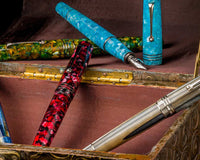For many fountain pen aficionados, the smoother their nib writes, the better. Some may want a little more feedback (which you can get from brands like Sailor or Platinum), but many are partial to the glass-like texture of a fountain pen nib writing on good paper.
One fascinating aspect of fountain pen nibs that is often the subject of debate is whether the nib changes over time with use. Some experienced users stand by this, saying that nibs are molded and shaped by the way a person writes. One related question that some fountain pen users ask is whether fountain pen nibs become smoother with use.
Do fountain pen nibs really get smoother with use?
Nibs and Wear
The more you write, the more your nib will undergo the process of wear. Similar to how a person’s shoes mold to their feet over time, nib wear will also occur the more you write. This is based on several factors, such as the way you write, how much pressure you apply, and your grip. Over time, you may come to enjoy your pen even more, but the opposite can also happen.
Heavy hands will wear out a nib more quickly. When it comes to the nib material, iridium tip nibs wear more slowly whereas gold tip nibs will wear more quickly. Paper also matters here; using coarse paper will increase wear while finer paper will decrease it.
Nib Smoothness

As you may have guessed by now, fountain pens can get smoother with use and wear. However, this is still highly dependent on several factors, particularly time and fountain pen material.
When considering the wear on your nib, such as when you are breaking in a new fountain pen, do remember that fountain pen nibs are quite durable, especially with additional tipping. It would take years and years of repeated regular use before a significant physical change can be observed.
There is also the aspect of you as the user that should be taken into account. The smoothness of your writing experience may be attributed to getting used to the pen. Over time, your hand position, grip, and writing angle adjust to the pen, giving you a better writing experience. This has more to do with you using the pen rather than the pen changing its physical shape.
Speeding up the process
If you prefer a much smoother nib and want to speed up the process of breaking in your pen, then there are ways to achieve this.
Rinsing the nib
Brand-new nibs might feel rough due to any residue that has come into contact with the pen during manufacturing. The nib might even be greasy. Cleaning it before use can help, and you can do so by rinsing it under clean lukewarm water.
Writing on coarse paper initially
Writing on coarse paper may not be the best experience, but it can help break in the nib more quickly than using smoother paper. This is almost like sanding the nib very, very gently.
Using a micromesh or a smoothing stick
A more aggressive method of smoothing out a nib is by using a micromesh. Take your pen and some water and write a few figure-eights on the mesh. Write on your paper to see if you need to repeat it based on your preference.
We recommend consulting with an experienced fountain pen friend or even a nibmeister before trying this last step.
The Bottom Line
To answer the question of whether or not fountain nib gets smoother with use, the short answer is yes they can. This is highly dependent on several factors as mentioned above, and it is due to both how the writer uses the pen and the pen’s physical changes over time.
Ultimately, the smoothness of a fountain pen is all up to preference, and there are several ways to get that experience. One way is to try different brands and models to see which suits your liking best, straight out of the box. The more experienced you become with writing using fountain pens, the more you’ll understand what pen works best for you.
Your writing can only become smoother from there.
By Some Folks at EndlessPens







